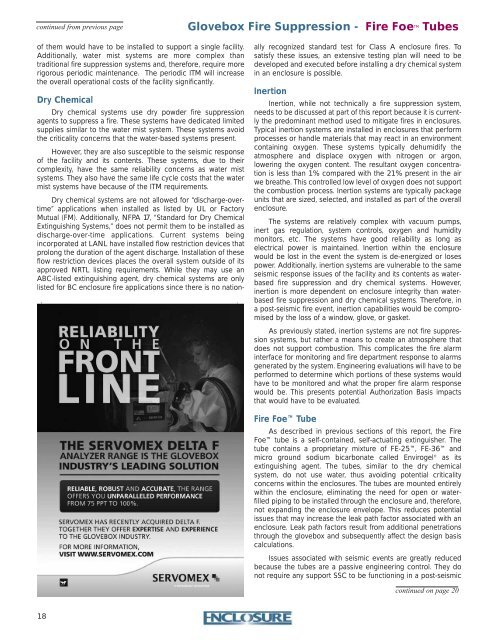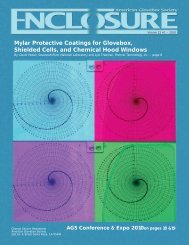Summary and Highlights - American Glovebox Society
Summary and Highlights - American Glovebox Society
Summary and Highlights - American Glovebox Society
Create successful ePaper yourself
Turn your PDF publications into a flip-book with our unique Google optimized e-Paper software.
continued from previous page<br />
of them would have to be installed to support a single facility.<br />
Additionally, water mist systems are more complex than<br />
traditional fire suppression systems <strong>and</strong>, therefore, require more<br />
rigorous periodic maintenance. The periodic ITM will increase<br />
the overall operational costs of the facility significantly.<br />
Dry Chemical<br />
Dry chemical systems use dry powder fire suppression<br />
agents to suppress a fire. These systems have dedicated limited<br />
supplies similar to the water mist system. These systems avoid<br />
the criticality concerns that the water-based systems present.<br />
However, they are also susceptible to the seismic response<br />
of the facility <strong>and</strong> its contents. These systems, due to their<br />
complexity, have the same reliability concerns as water mist<br />
systems. They also have the same life cycle costs that the water<br />
mist systems have because of the ITM requirements.<br />
Dry chemical systems are not allowed for “discharge-overtime”<br />
applications when installed as listed by UL or Factory<br />
Mutual (FM). Additionally, NFPA 17, “St<strong>and</strong>ard for Dry Chemical<br />
Extinguishing Systems,” does not permit them to be installed as<br />
discharge-over-time applications. Current systems being<br />
incorporated at LANL have installed flow restriction devices that<br />
prolong the duration of the agent discharge. Installation of these<br />
flow restriction devices places the overall system outside of its<br />
approved NRTL listing requirements. While they may use an<br />
ABC-listed extinguishing agent, dry chemical systems are only<br />
listed for BC enclosure fire applications since there is no nation-<br />
18<br />
<strong>Glovebox</strong> Fire Suppression - Fire Foe TM Tubes<br />
ally recognized st<strong>and</strong>ard test for Class A enclosure fires. To<br />
satisfy these issues, an extensive testing plan will need to be<br />
developed <strong>and</strong> executed before installing a dry chemical system<br />
in an enclosure is possible.<br />
Inertion<br />
Inertion, while not technically a fire suppression system,<br />
needs to be discussed at part of this report because it is currently<br />
the predominant method used to mitigate fires in enclosures.<br />
Typical inertion systems are installed in enclosures that perform<br />
processes or h<strong>and</strong>le materials that may react in an environment<br />
containing oxygen. These systems typically dehumidify the<br />
atmosphere <strong>and</strong> displace oxygen with nitrogen or argon,<br />
lowering the oxygen content. The resultant oxygen concentration<br />
is less than 1% compared with the 21% present in the air<br />
we breathe. This controlled low level of oxygen does not support<br />
the combustion process. Inertion systems are typically package<br />
units that are sized, selected, <strong>and</strong> installed as part of the overall<br />
enclosure.<br />
The systems are relatively complex with vacuum pumps,<br />
inert gas regulation, system controls, oxygen <strong>and</strong> humidity<br />
monitors, etc. The systems have good reliability as long as<br />
electrical power is maintained. Inertion within the enclosure<br />
would be lost in the event the system is de-energized or loses<br />
power. Additionally, inertion systems are vulnerable to the same<br />
seismic response issues of the facility <strong>and</strong> its contents as waterbased<br />
fire suppression <strong>and</strong> dry chemical systems. However,<br />
inertion is more dependent on enclosure integrity than waterbased<br />
fire suppression <strong>and</strong> dry chemical systems. Therefore, in<br />
a post-seismic fire event, inertion capabilities would be compromised<br />
by the loss of a window, glove, or gasket.<br />
As previously stated, inertion systems are not fire suppression<br />
systems, but rather a means to create an atmosphere that<br />
does not support combustion. This complicates the fire alarm<br />
interface for monitoring <strong>and</strong> fire department response to alarms<br />
generated by the system. Engineering evaluations will have to be<br />
performed to determine which portions of these systems would<br />
have to be monitored <strong>and</strong> what the proper fire alarm response<br />
would be. This presents potential Authorization Basis impacts<br />
that would have to be evaluated.<br />
Fire Foe Tube<br />
As described in previous sections of this report, the Fire<br />
Foe tube is a self-contained, self-actuating extinguisher. The<br />
tube contains a proprietary mixture of FE-25, FE-36 <strong>and</strong><br />
micro ground sodium bicarbonate called Envirogel ® as its<br />
extinguishing agent. The tubes, similar to the dry chemical<br />
system, do not use water, thus avoiding potential criticality<br />
concerns within the enclosures. The tubes are mounted entirely<br />
within the enclosure, eliminating the need for open or waterfilled<br />
piping to be installed through the enclosure <strong>and</strong>, therefore,<br />
not exp<strong>and</strong>ing the enclosure envelope. This reduces potential<br />
issues that may increase the leak path factor associated with an<br />
enclosure. Leak path factors result from additional penetrations<br />
through the glovebox <strong>and</strong> subsequently affect the design basis<br />
calculations.<br />
Issues associated with seismic events are greatly reduced<br />
because the tubes are a passive engineering control. They do<br />
not require any support SSC to be functioning in a post-seismic<br />
continued on page 20





